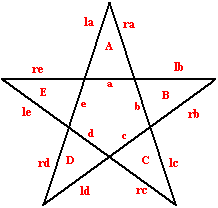
THE PROBLEM Following Ken Duisenberg (LINK TO MODIFY WHEN THE PROBLEM WILL BE MOVED INTO ARCHIVES) we want to assign the numbers 1-15 to each of the line segments on a 5-pointed star such that every line and every small triangle has the same sum.
NOTATIONS We denote by a, b, c, d, e the values we will put on the bases of the triangles A, B, C, D, E respectively; using "l" for left and "r" for right, the corresponding sides will be denoted by la,ra; lb,rb and so on.
If S denotes the common value of the 10 sums, taking into account that any value appears into two sums, we must have 10*S=2*(1+2+...+15); thus S=24. Remark that the discussion could be somewhat shortened by using, instead of the numbers (1,...,15), the numbers (-7,...,+7); say substracting 8 to each entry. In particular, the common value of the sums becomes 0.
REDUCTION OF CASES A quite obvious reduction of cases is given by the remark that rotations and/on symmetries transform solutions into solutions; in particular a rotation allows us to assume a < b, c, d, e; then, possibly using a symmetry with respect the base of the triangle A, we can assume b < e. The following two properties are somewhat less obvious:
STRATEGY A possible strategy could be to fix 6 elements (suitably choosen, e.g. the bases a, b, c, d, e and the side la); then imposing the value 24 to the 10 sums we get a unique set of 15 values, that we will obviously accept only if the resulting 15-tuple coincide with the set (1,...,15). Of course this is too expansive, but the previous remarks can shorten the work:
RESULTS The resulting program (written in any language faster than JavaScript!) will output 6 solutions with SB < 40 and 3 solutions (all autodual) with SB = 40. In particular, if we only search for solutions modulo rotations and/or symmetry, the problem has 30 solutions.